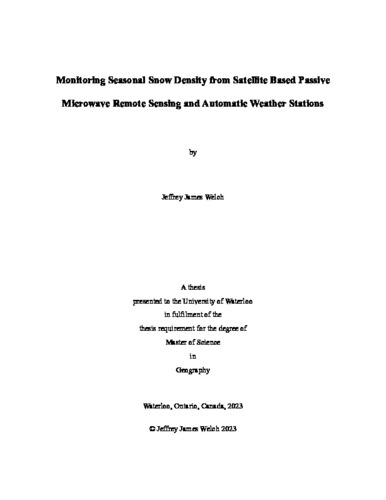| dc.contributor.author | Welch, Jeffrey | |
| dc.date.accessioned | 2023-10-26 14:52:51 (GMT) | |
| dc.date.available | 2023-10-26 14:52:51 (GMT) | |
| dc.date.issued | 2023-10-26 | |
| dc.date.submitted | 2023-10-18 | |
| dc.identifier.uri | http://hdl.handle.net/10012/20064 | |
| dc.description.abstract | Seasonal snow plays an important role in Earth’s systems and for hydrological applications one of the most important properties is the quantity of liquid water stored in the snowpack, referred to as snow water equivalent (SWE). SWE is related to the depth and density of a snowpack, so accurate estimates of both those properties are necessary to estimate SWE. However, the current understanding of snow density is limited to sparsely distributed in situ samples, which is especially limiting in an environment with restricted access like the Canadian tundra. Models can be used to estimate snow density in lieu of in situ sampling and there are a variety of such models available. However, it was determined that none of the available snow density models were entirely suitable for an environment like the Canadian tundra, each for their own reasons.
A new remote sensing algorithm was proposed to estimate snow density from satellite based passive microwave observations and operational automatic weather station (AWS) networks. In this research, an experiment was designed to evaluate the potential for the remote sensing algorithm to monitor snow density in the Canadian Tundra. AWS data were used parametrize a two-layer snowpack model (representing a depth hoar layer underlying a wind slab) and 3D gradient descent machine learning was used to isolate the volume scattering contributions of each layer density independently. New components were added to the machine learning cost function to incorporate prior knowledge and constrain the model’s behaviour. The model was trained at the AWS site in Eureka, Nunavut and was then applied to AWS sites distributed across the Canadian tundra. Model performance was quite consistent at high arctic sites but began to degrade across the subarctic with increased distance from the training site, suggesting the need for more robust model training and forcing in the future. Estimation skill consistently improved over the course of algorithm runs and snow density estimates were often close to the ±10% uncertainty range of the in situ samples by the end of the season – showing good promise for estimating snow density at peak SWE accumulation, which could be useful for applications where total water storage in the snowpack is of concern. | en |
| dc.language.iso | en | en |
| dc.publisher | University of Waterloo | en |
| dc.subject | remote sensing | en |
| dc.subject | snow | en |
| dc.subject | swe | en |
| dc.subject | density | en |
| dc.subject | passive microwave | en |
| dc.subject | machine learning | en |
| dc.title | Monitoring Seasonal Snow Density from Satellite Based Passive Microwave Remote Sensing and Automatic Weather Stations | en |
| dc.type | Master Thesis | en |
| dc.pending | false | |
| uws-etd.degree.department | Geography and Environmental Management | en |
| uws-etd.degree.discipline | Geography | en |
| uws-etd.degree.grantor | University of Waterloo | en |
| uws-etd.degree | Master of Science | en |
| uws-etd.embargo.terms | 0 | en |
| uws.contributor.advisor | Kelly, Richard | |
| uws.contributor.affiliation1 | Faculty of Environment | en |
| uws.published.city | Waterloo | en |
| uws.published.country | Canada | en |
| uws.published.province | Ontario | en |
| uws.typeOfResource | Text | en |
| uws.peerReviewStatus | Unreviewed | en |
| uws.scholarLevel | Graduate | en |

